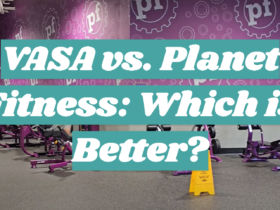Are you feeling confused about whether you should choose the gym or yoga for a healthier body and mind? While some people swear by their daily trips to the gym, others find solace in a peaceful yoga class. Multiple factors come into play when deciding between these two beloved fitness practices – each offering unique benefits for your body and mind. Having reviewed both sides of the argument, this blog post is here to help you make an educated decision on which is the better fit for you.
What Are the Benefits of Doing Yoga?
Yoga is one of the oldest forms of exercise in the world, and it has many benefits for your physical, mental, and spiritual health. The practice involves stretching, posture work, and deep breathing which helps to strengthen muscles, improve flexibility and reduce stress levels. Regular yoga practice can also help to improve balance and coordination as well as improve concentration and focus. Yoga can also help to enhance overall well-being by increasing self-awareness and calming the mind.
Finally, yoga can also benefit you spiritually by helping to connect body and mind, creating a sense of inner peace and harmony with the world. As you can see, there are many benefits to doing yoga regularly. Not only will it help improve your physical health but it can also help to improve mental clarity and spiritual well-being. So why not give it a try? You may just find that you love it [1]!

How to Get Started with Yoga
Starting yoga for the first time can be intimidating but don’t let that stop you from trying something new. Here are some tips for starting out:
- Find a comfortable and quiet place – Make sure to choose a space where you feel relaxed, comfortable, and free from distraction.
- Choose the right type of yoga – There are many different types of yoga so make sure to do your research before choosing one that’s best for you.
- Start slowly – Don’t try to tackle too much at once. Start with basic poses and work your way up as you become more experienced.
- Stay focused – Yoga is about being present at the moment, not thinking about what happened yesterday or tomorrow. Try to stay focused on your practice throughout the session.
- Listen to your body – If something feels wrong or uncomfortable, stop doing it and take a break until you feel ready to continue.
By following these tips, you will be able to get started with yoga in no time and begin reaping the amazing benefits of this ancient practice. So what are you waiting for? Get out there and start your yoga journey today [2]!
What Are the Benefits of Going to the Gym?
Going to the gym is a great way to stay fit and healthy. Working out in the gym can provide many benefits, such as improved cardiovascular health, increased strength, weight loss or maintenance, stress relief, and improved mood. Regular trips to the gym can also help maintain overall mental and physical well-being. Here are some of the top benefits of going to the gym:
- Improved Cardiovascular Health: Regular exercise helps improve your heart health by strengthening it and improving circulation. It also helps lower blood pressure, reduce cholesterol levels and reduces the risk for diseases like diabetes and heart disease.
- Increased Strength: Lifting weights and using resistance machines at the gym can help strengthen muscles which can support bones, joints, and ligaments. This can help improve posture, reduce the risk of injury, and even boost your energy levels.
- Weight Loss or Maintenance: Going to the gym regularly is an effective way to burn calories and lose weight. Strength training in particular is more effective than cardio for long-term fat loss. Additionally, going to the gym can help maintain a healthy body weight by providing an environment that promotes calorie burning, muscle growth, and improved metabolism.
- Stress Relief: Working out at the gym can provide a great outlet for stress relief after a long day of work or school. It can also release endorphins which trigger positive feelings in the brain and promote relaxation.
- Improved Mood: Exercise releases endorphins and serotonin, hormones that can help boost mood. Exercise also increases energy levels, which in turn can improve your outlook on life. Overall, going to the gym can be a great way to improve your mental health and overall well-being.

The Benefits of Yoga vs. Gym
Yoga can be free or cost less than a gym membership
Yoga doesn’t require any special equipment, and you can practice for free in parks, at home, or with online videos. Even if you do decide to take classes or invest in props like straps, it will still be much cheaper than a gym membership.
Yoga incorporates breathing and meditation techniques
The physical poses of yoga are beneficial, but the mental benefits can be even more profound. As opposed to gyms where the focus is entirely on exercise, yoga also emphasizes mindfulness through breathing exercises, guided visualizations, and meditation. These practices increase self-awareness, reduce stress levels, and help to foster feelings of peace.
There are many types of yoga to choose from
The beauty of yoga is that there are many types and styles, making it accessible to everyone. Whether you prefer to practice a gentle form like Hatha or get your heart pumping with Vinyasa, the variety of options helps ensure that everyone can find something that works for them.
Yoga develops body awareness
Since yoga involves paying attention to breathwork and how your body moves as you move through the poses, it’s an excellent way to develop greater body awareness. This kind of knowledge is key when it comes to honoring your physical limitations and preventing injury in any sport or exercise program.
Yoga has long-term benefits
Unlike competitive sports or intense workouts at the gym where you may experience quick results but have to keep up the intensity to maintain them, yoga is more gradual and sustainable. Over time, consistent practice will lead to strength, flexibility, and balance. This makes it an ideal form of exercise for people of all ages.

Yoga is a holistic approach to fitness
The physical benefits of yoga are clear – improved strength and flexibility, better posture and coordination – but the mental benefits shouldn’t be overlooked either. Yoga combines breathwork with mindfulness and relaxation techniques that help develop both physical and mental resilience. It can also boost your mood and outlook on life.
Yoga can help increase flexibility
Yoga is renowned for its ability to increase flexibility, which can help reduce the risk of injury and make daily tasks easier. As you hold poses longer, your muscles will eventually relax and become more flexible. With regular practice, you’ll be able to find greater ease in everyday activities like bending down to tie your shoes or reaching overhead to grab something off a shelf.
Yoga can provide relief from stress and anxiety
The breathwork component of yoga helps calm both the body and mind, reducing levels of stress hormones such as cortisol. Additionally, meditating during yoga practice helps develop focus and presence while allowing worries to drift away. This can have long-term benefits since it sets up a pattern for when life gets turbulent outside of the studio.
Yoga can help you to increase your energy and focus
The combination of mindful breathing, stretching, meditation, and relaxation helps to improve circulation throughout the body. This increased blood flow delivers more oxygen to muscles and organs which can help boost energy levels and mental clarity. Additionally, yoga encourages stillness in the mind which can help sharpen focus and concentration.
Yoga can help build strength
Many people think of yoga as being gentle and restorative, but it can also be physically challenging. Depending on the style, some classes will involve a series of dynamic poses that help to build strength in the arms, legs, and core. And since no equipment is necessary, you’re able to practice anywhere without any additional cost or hassle.
Yoga can be adapted for all levels
Yoga is accessible to everyone regardless of age, experience level, or physical ability. Thanks to modifications and props like blocks and straps, the same postures can be adapted to suit different body types while still offering the same benefits. This makes yoga an ideal form of exercise for anyone looking to get fit without spending too much money or time.

Yoga is a great way to stay active and healthy
By combining strength, flexibility, and mindfulness into one practice, yoga offers a holistic approach to overall health and well-being. Through regular practice, you can enjoy increased energy levels, improved body awareness and posture, and greater resilience to stress. Plus, it’s fun [3]!
The Disadvantages of Yoga vs. Gym
When it comes to the disadvantages of Yoga vs. Gym, there are a few key differences that should be taken into consideration. Firstly, while Yoga is often seen as a more holistic form of exercise, it is not as effective in developing strength and building muscle mass compared to training with weights and equipment found in gyms.
Additionally, Yoga may not be suitable for everyone due to its slower pace and lack of intensity. Furthermore, some people may find yoga to be too slow or repetitive, making it difficult for them to stick with the practice regularly.
Lastly, since many classes are taught by instructors with varying levels of experience and expertise in the field, it can be hard to ensure you’re getting an optimal level of instruction from all participants.
Ultimately, when deciding whether Yoga or Gym is right for you, it’s important to evaluate your individual needs and what works best in terms of achieving your desired outcomes safely. Both forms of exercise do have their advantages and disadvantages; however, with careful consideration, you can choose the one that will be most beneficial for you.
The Benefits of Gym vs. Yoga
The gym may provide personal trainers
Gym helps you reach your fitness goals faster or motivates you to stick with the plan. Gym-goers also have access to various machines and equipment that can target specific muscles and body parts, making it easy for people of all fitness levels to customize their workouts. However, gym memberships can often be expensive and require more time commitments than yoga.
The gym can help your health
Regular physical activity is important for overall health and well-being. Working out at the gym can help maintain a healthy weight, strengthen muscles, reduce stress and anxiety, improve blood circulation, increase energy levels, reduce the risk of chronic diseases like heart disease and diabetes, improve posture and flexibility, boost mood, and improve sleep quality.

A gym can offer a variety of workouts
Gyms are great because they can accommodate a variety of workouts. Whether you want to lift weights, take part in group classes, use the treadmill or an elliptical machine, get in cardio, or practice yoga and Pilates, gyms typically offer it all.
Yoga is low-impact
Yoga is a low-impact form of physical activity that helps strengthen your muscles and improve flexibility. It also has mental benefits such as reducing stress and anxiety while improving focus and concentration. Yoga can be done almost anywhere with minimal equipment required — just a mat and comfortable clothing — making it perfect for those who don’t have access to a gym or can’t afford pricey memberships. Additionally, many yoga studios offer classes for all skill levels, so there’s something for everyone.
The gym is a great place to socialize
The gym is a great place to socialize and meet new people. It can be motivating to work out with other people, which helps keep you accountable and motivated to stay on track. There are also many group fitness classes offered at most gyms, which provides an opportunity for members to form relationships and support one another as they reach their goals.
Yoga is more cost-effective
Yoga classes are generally much more affordable than gym memberships. You don’t need expensive equipment or machines — just a comfortable mat, some light weights or resistance bands, and loose-fitting clothes — so you won’t have to break the bank just to stay fit. Additionally, yoga studios often offer discounts or packages that make classes even more affordable.
Can you Replace the Gym with Yoga?
Absolutely! You don’t need to go to the gym to stay fit and healthy. Yoga is a great alternative that can help you build strength, improve flexibility and even reduce stress levels. It’s also low-impact, meaning it won’t put as much strain on your body as high-intensity workouts that require equipment or weights.
Yoga provides all the same benefits as going to the gym without any of the extra cost or hassle of having to leave your home. Plus, with online classes, apps, and tutorials available for free or at a fraction of the cost of a gym membership, what’s not to love?
The key is finding a practice that works for you – look into different styles, intensities, and lengths of classes to find one that you enjoy doing regularly. And if you’re looking for an extra challenge, you can always incorporate light weights or resistance bands into your practice to increase the intensity.
No matter what level you’re at, yoga is a great way to keep your body moving and give yourself some time and space for self-care. So don’t be afraid to switch up your routine – get creative with it! As long as you stay consistent with it, yoga can be just as effective as any gym workout.
FAQ
Which is better, the gym or yoga, to lose weight?
This is a difficult question as it depends on individual preferences and goals. Generally speaking, both the gym and yoga can help you lose weight. However, if your goal is to build strength or muscle mass then the gym may be the better option, while if your goal is to increase flexibility or reduce stress then yoga will likely be more beneficial. In either case, it’s important to find an activity that you enjoy and stick with it for the best results.
Can yoga replace gym?
No yoga cannot replace the gym as it offers different benefits. The gym has more options for specific muscle groups’ equipment that can help with weight loss and strength building, while yoga is better for improving flexibility, balance, and relaxation. Depending on your individual fitness goals, you may want to combine both activities or alternate between them depending on what you need at any given time.

What are the benefits of doing yoga?
Yoga offers a variety of health benefits, including improved flexibility and balance, increased strength and endurance, improved posture, reduced stress levels, and improved mental clarity. It can also be used as a form of meditation that helps to calm the mind and body. Additionally, it is low-impact so it’s suitable for people of all ages and fitness levels.
How often should I do yoga?
As with any exercise routine, it’s important to listen to your body and not overdo it. In general, experts recommend trying to practice yoga at least three times a week for the best results. To maximize the benefits, you should focus on making each session count by maintaining proper form and focusing on your breath throughout.
What are some common mistakes beginners make when practicing yoga?
Some of the most common mistakes beginners make when practicing yoga include using poor form, pushing too hard, not being mindful of their breathing, and not taking enough breaks. It is important to start slow and gradually build up the intensity as you become more comfortable with the poses. Additionally, always remember to listen to your body and take breaks when necessary.
What are some tips for starting a yoga practice?
If you’re just getting started with yoga, here are some tips to help you get the most out of it:
- Set realistic goals and expectations
- Research different styles of yoga classes and find one that suits your needs
- Invest in quality equipment such as a mat, blocks, straps, etc.
- Make sure to warm up before each session and cool down afterward
- Focus on your breathing throughout each pose or movement
- Take regular breaks as needed and be mindful of any discomfort or pain that you may experience
These tips can help ensure that you stay safe, avoid injury, and get the most out of each yoga session.
Is yoga better than weights?
Again, this depends on your individual goals. Weight training can help to build muscle mass and strength, while yoga can help to improve flexibility, balance, and relaxation. Depending on what your specific fitness goals are you may want to combine both activities or alternate between them depending on what you need at any given time.
What type of yoga is best for beginners?
Hatha yoga is a great option for beginners as it focuses on basic postures and breathing techniques and doesn’t require any special equipment. This style of yoga incorporates gentle stretching and poses that don’t require too much strength or flexibility. Additionally, many different variations of Hatha yoga focus on different aspects such as meditation or spiritual exploration.
Why is yoga more important than the gym?
Yoga is important for many reasons, but it does not necessarily replace the gym. The gym has more options for specific muscle groups’ equipment that can help with weight loss and strength building, while yoga is better for improving flexibility, balance, and relaxation. Depending on your individual fitness goals, you may want to combine both activities or alternate between them depending on what you need at any given time. Additionally, yoga is a great way to develop mental clarity and reduce stress levels which are important factors in overall health and well-being.
Useful Video: Yoga vs Gym | Which one is better?
Conclusion
Yoga or Gym? Ultimately, the answer to this question depends on your individual needs and preferences. Yoga is a great way to practice mindfulness, build strength and flexibility, and improve overall health and well-being. On the other hand, going to the gym can provide more intense physical activity in a variety of forms that may be better suited to those looking for anaerobic exercise or competitive sports. Whatever you decide, both yoga and gym offer many benefits that can help you lead a healthier lifestyle. The best thing you can do for yourself is to find something that works for you – whether it’s yoga or gym – and stick with it!
References:
- https://www.hopkinsmedicine.org/health/wellness-and-prevention/9-benefits-of-yoga
- https://www.rei.com/learn/expert-advice/getting-into-yoga.html
- https://www.doyou.com/15-reasons-yoga-is-better-than-the-gym/










Leave a Review